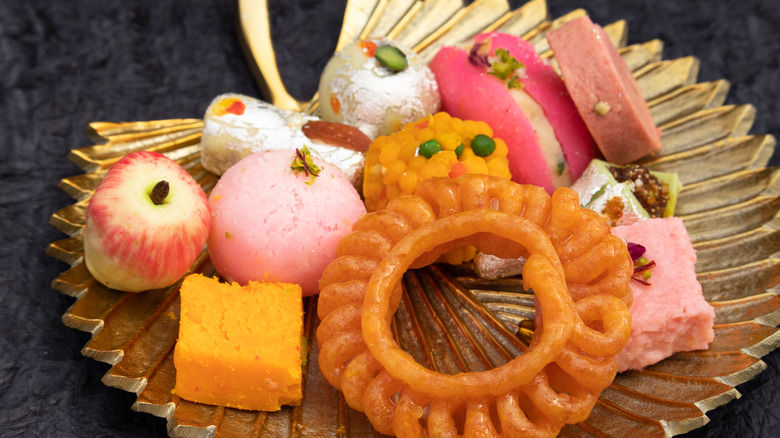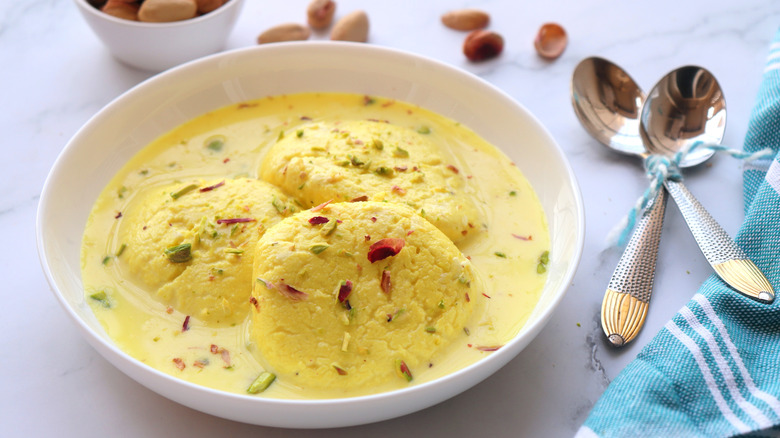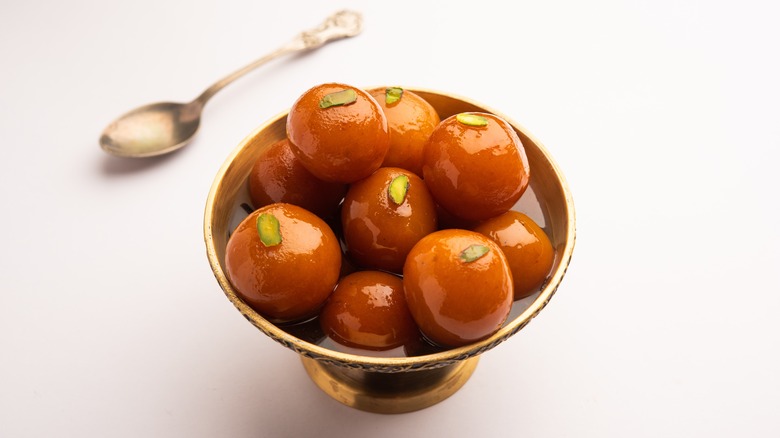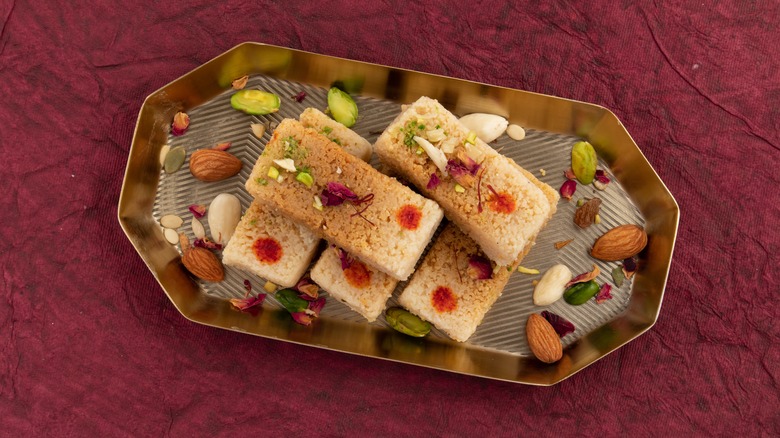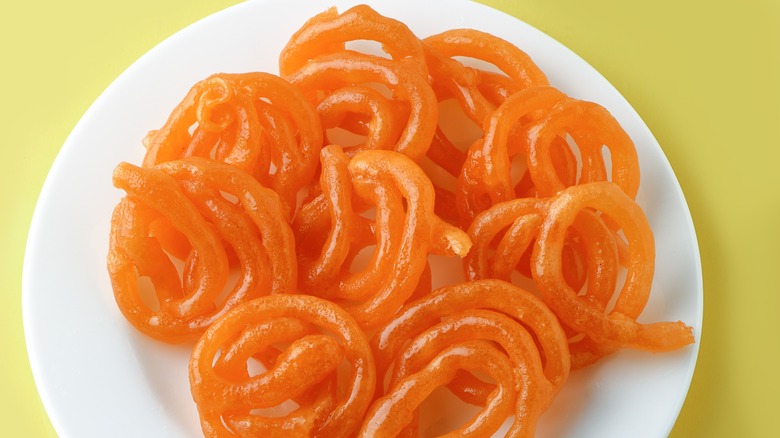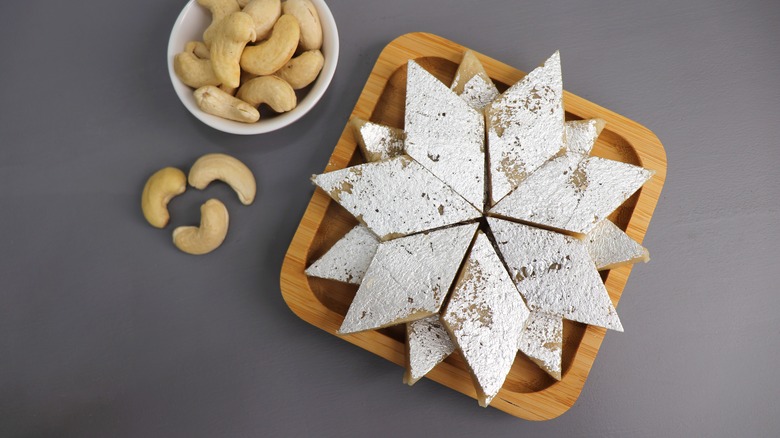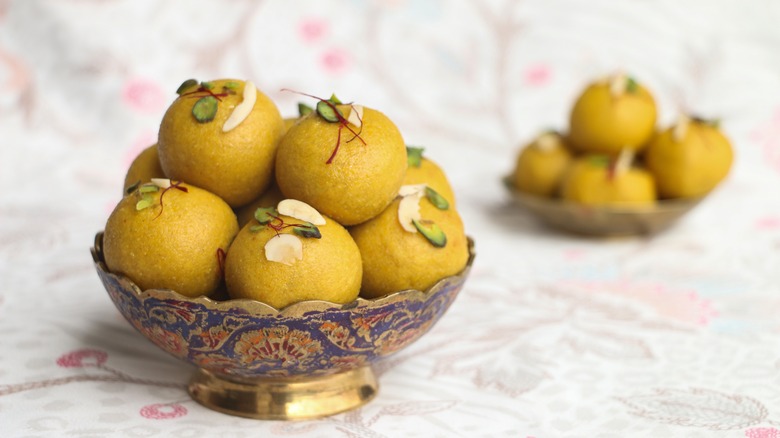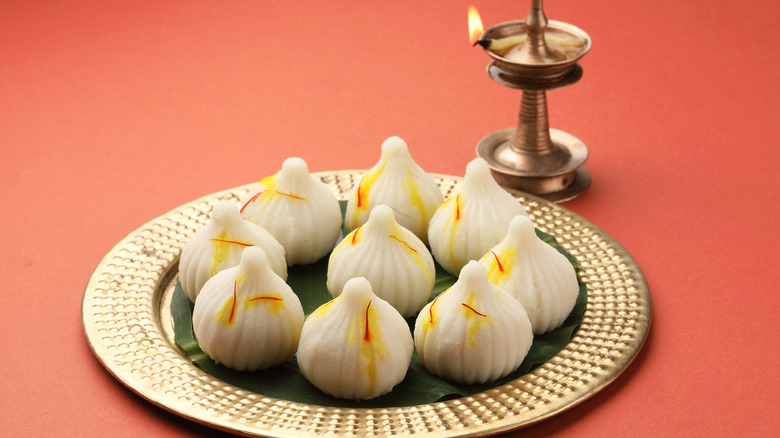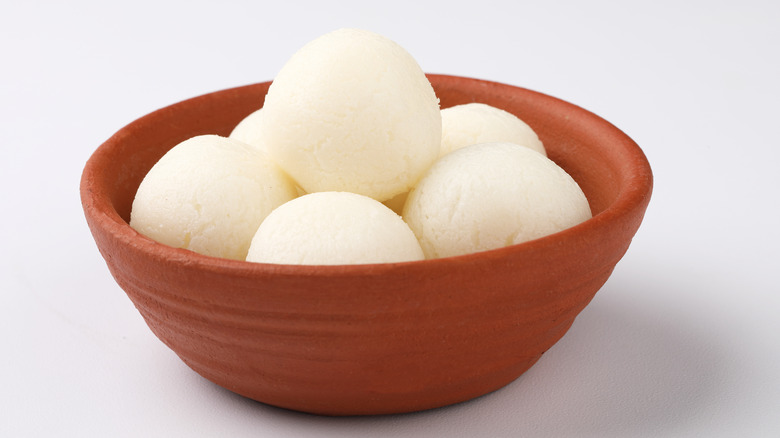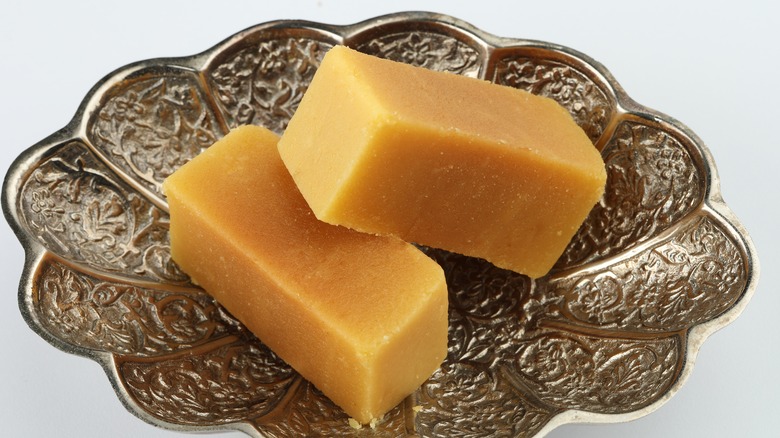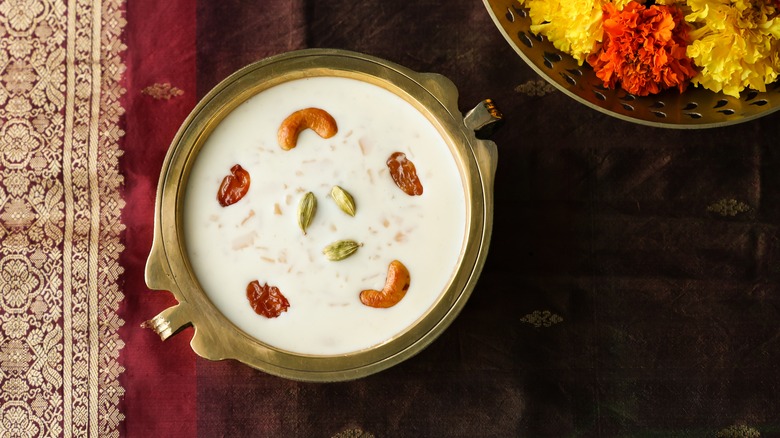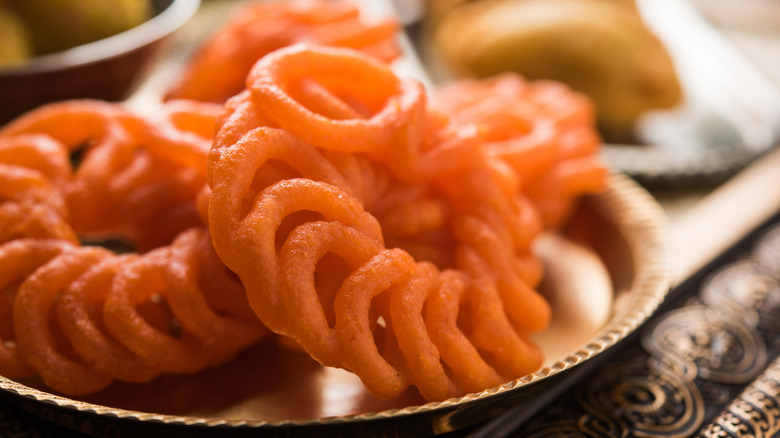A Guide To India's Most Mouthwatering Sweets
In the Western world, India may be best known for savory dishes with complex flavors, but it's also home to a staggering variety of bite-sized foods. These include indulgent sweets called mithai. An important piece of the culture and traditions of India, mithai are rich, delectably sweet, and often vibrantly colorful, sometimes featuring edible gold or silver foil to add some extra glitz. Indian sweets are frequently served during festivals like Holi, the festival of colors, and Diwali, the festival of lights. While these events may often show off elaborate displays of sweets, these treats can be found on sale at any time of year for anyone with a sweet tooth.
Mithai have held a place in traditional South Asian cuisine for a long time, by far predating the modern state of India. Needless to say, with such a long history, a wide variety of sweet treats can now be found across India, as well as in the other countries of South Asia like Pakistan, Nepal, and Bangladesh. However, they can be a little confusing for English speakers at first glance. Where English draws distinctions between things like cakes and candies, for instance, mithai aren't so easily categorizable. Some mithai can just as easily be served as a dessert after a hearty dinner as they can be tasty snacks to enjoy with afternoon tea.
Ras malai
Sweet and milky, ras malai are a favorite across much of India. These are small, spongy puddings often flavored with sweet spices like cardamom, saffron, and chopped pistachios and served in a sweet, milky sauce. The main ingredient is Indian cottage cheese, either chenna or paneer, making this dish a little bit like an Indian cheesecake. Smooth and creamy, ras malai are often prepared at home; in kitchens across India, they're made from scratch using whole milk as a starting ingredient. Milk curds are shaped into disks and then boiled in hot sugar syrup, giving the ras malai their springy, spongy texture. This is what gives the soft, melt-in-the-mouth finish which makes them so moreish.
Making ras malai at home may seem a bit advanced for beginners, but they're not difficult to make with a little practice. All the same, if ras malai feel beyond your kitchen skill level, they're quite easy to find on sale in Indian sweet shops. Pre-packaged ras malai keep for a long time, and a bowl of them can make for a satisfying dessert after a large meal. In India, they're often served as dessert during wedding banquets and other celebrations.
Gulab jamun
Gulab jamun may be the most famous of South Asia's many mithai, enjoyed all over India and celebrated as a national dish of Pakistan. Deep-fried to give them a warm, golden exterior, they're served in fragrant syrup scented with rose water — this Indian sweet is named after the Persian word for "rose." Like many other mithai, a central ingredient in gulab jamun is khoya (milk solids), although modern recipes use milk powder to cut down on preparation time.
A bowl of gulab jamun usually has an inviting golden color, from both the deep-fried pieces themselves and the sweet syrup. They can make a blissfully indulgent dessert after a big meal. In India, they're popularly enjoyed during festivals like Diwali and Holi, as well as being popular during Eid as a sweet treat after the holy month of Ramadan. They're by no means confined to festivals, though, and are enjoyed across India at any time of year. They can be made at home with a little practice, and boxes of powdered gulab jamun mix aren't too difficult to find in Indian supermarkets. If it's easier, though, Indian sweet shops often sell gulab jamun, either made on-site or pre-packaged. However you get them onto your dining table, this is certainly one Indian sweet that you won't want to miss out on!
Burfi
Where the Western world has fudge, South Asia has burfi. Quite similar to some types of fudge in both taste and texture, burfi is usually prepared in blocks that can be sliced into small pieces. Often colorful and fragranced with a subtle hint of sweet spices, burfi comes in all kinds of varieties. Three popular versions of this mithai can be made with coconut, carrot, or pistachio. These are just the tip of the iceberg, though. Other versions can include semolina, gram flour, figs, dates, ground almonds, or even chocolate. As decorative as they are colorful, a plate of arranged burfi makes a great centerpiece on a dessert table.
The name burfi comes from words in Persian and Urdu, meaning "snow" or "ice," very likely for the snowy appearance and texture of some types of burfi. This also hints that burfi may have been the inspiration for a traditional English sweet named coconut ice, a recipe dating back to the 19th century during colonial times. Similarly to coconut burfi, this fudge-like sweet is made with coconut and condensed milk. It's popularly associated with warm weather in the U.K., although it lacks the flavors of ghee and cardamom which make Indian burfi so fragrant.
Jalebi
Anyone from South Asia will likely be familiar with jalebis. These sugary treats are widely sold as street food at small vendor stalls, a little like funnel cake in the U.S. For a few rupees, vendors will cook jalebis fresh while you watch. They're made by piping batter from something like an icing bag or a squeezable sauce bottle, making spiraling shapes in a hot pan. These are then fried until crispy and dipped in fragrant syrup before being served. The batter usually includes some cornstarch for added crunch and a little yogurt for flavor. To give the characteristic vibrant orange color that jalebis are known for, the batter usually includes a pinch of turmeric, and the syrup often contains saffron.
Popular across the entire Indian subcontinent, jalebis are best known as street food, but they're also enjoyed during celebrations. Indian sweet shops often sell them pre-made, with many places keeping little cartons containing a few jalebis alongside the other mithai on offer. Most people will agree, however, that these sweets are best by far when freshly cooked and still warm. Fortunately, if you don't have any nearby street stalls to buy them from, jalebis are not difficult to make at home.
Kaju katli
A particular type of burfi, kaju katli are thin sweets with a slightly firmer texture than some of the others on this list. They're most often sliced into characteristic diamond shapes and are often given as welcome gifts or to family and friends; if you're invited to an Indian home, a gift of kaju katli is likely to be well received! Intended to be decorative and eye-catching, kaju katli in gift boxes are usually lined with edible silver leaf to make them more attractive. These sweets are popular in North India, with a flavor and texture quite similar to marzipan. Instead of almonds, though, they're made with finely ground cashew nuts, giving them a rich and wholesome flavor.
Kaju katli is a firm favorite variety of Indian sweet, and one of the most universally popular throughout the entire year. Decadent, with a melty texture and the wholesome flavors of ghee and cashews, it can also be flavored with rose water, cardamom, or saffron. It's also quite easy to make at home, with just a handful of ingredients. Making your own also lets you substitute the ghee for coconut oil, creating a version of kaju katli which can be enjoyed by vegans and people with dairy intolerances. Of course, homemade nearly always tastes better than store bought and can be far more meaningful if you decide to give it as a gift.
Ladoo
Small balls of sweet, fragrant goodness, ladoos are a beloved Indian sweet enjoyed all across South Asia. They often have a soft, slightly powdery texture, but this can vary as much as the ingredients in ladoos. They can be made with semolina, sesame, peanut, and jaggery, among other ingredients. In fact, they're possibly the most ubiquitous sweet in India, with plates of them served at virtually every kind of ceremony and festival, and with every part of India having its own distinctive version. Part of the reason for this is that these sweets have an impressively long history. Ladoos may well be the oldest type of mithai, dating back to the ancient Harappan civilization 4,000 years ago.
Probably the best-known variety of these mithai is besan ladoo. Made with gram flour as the main ingredient and slowly cooked in hot ghee until fragrant, these ladoos have a rich, nutty flavor that'll almost surely make you want to reach for more. They're not difficult to make at home, either — certainly no more difficult than American fudge — and cooking a pan full of gram flour will fill your entire kitchen with a beautiful fragrance. Arranging a decorative plate of these small, round sweets can make a nice way to welcome houseguests for any occasion.
Modak
There are a huge variety of dumplings eaten across Asia, but most contain savory fillings. Modak are different — these Indian dumplings always have a sweet filling! Typically handmade and cooked in a steamer, they're eaten in several different parts of India and sometimes even go by different names, like kudumu or kozhukattai. The dumpling wrappers for modak are made from rice flour, giving them a slightly translucent white appearance, although colorings are sometimes added. Their filling is usually a mixture of coconut and jaggery, sometimes also with poppy seeds, flavored with subtle hints of cardamom and nutmeg. The fillings can vary, though, with different ones popular in different Indian states. Some are also made following family recipes, passed down through the generations.
Modak, according to legends, are a favorite food of the Hindu god Ganesha. The god of wisdom and intellect, Ganesha is said to be able to offer protection and help people get past life's obstacles. He's widely worshipped in India, and people often make modak to offer to Ganesha at temples during religious festivals. Popular ones are Sankashti Chaturthi, an auspicious day that happens every month, and Ganesh Chaturthi, a 10-day festival around August and September of each year.
Rasgulla
These round, white sweets are made from chenna, a kind of cottage cheese that's usually prepared at home from milk curds. Made fresh and strained with cheesecloth, the chenna is shaped into small balls and cooked in sugar syrup until light and spongy. The finished rasgullas usually have a similar texture to ras malai but are served in syrup like gulab jamun. These are another essential part of many Indian festivals, particularly in Bengal and Orissa, where they originated. Kewra water is sometimes added to give the finished sweets a sweet fragrance. Rasgullas also have an additional cultural significance; this sweet symbolizes well-being.
Like many of the other types of mithai, rasgullas are quite easy to make at home with a little practice. At their most basic, the sweets themselves are essentially just made from milk curds, and the syrup they're served in is usually made with white sugar and flavored with rose water (and occasionally a little saffron). Regional recipes vary a little, with some calling for fresh milk to be curdled with lemon juice to make the chenna, and some involving yeast to expand and give the finished rasgullas a softer, more spongy mouthfeel. Whichever recipe you choose to follow, these soft, slightly crumbly sweets should have an irresistible juicy texture when you bite into them.
Mysore pak
Another distinctive type of burfi, these luxurious sweets are made with fragrant ghee and wholesome gram flour, usually coloring them either a sunny yellow or a fudgy brown. A relatively recent invention from the 1930s, these are named for the city of Mysore (aka Mysuru) in the South Indian state of Karnataka, where they were created. In fact, they were originally a royal delicacy, first prepared for Maharaja Krishnaraja Wodeyar. A chef was trying to create a unique treat for a royal lunch, and the Maharaja enjoyed it so much that it became known as a favorite among the royal family. Holding such prestige, the popularity of this mithai only continued to grow.
Mysore pak is a distinctly South Indian dish, popularly enjoyed at weddings and baby showers. Dense and buttery, it's often flavored with ingredients like rose and honey. Well-made Mysore pak will have the softness of a good fudge and will quite literally melt in your mouth. There are a couple of different versions of this sweet, too. The traditional Mysore pak is harder and more porous, but a softer version has proven to be far more popular and is now enjoyed across India.
Kheer
Rice pudding is an easy dessert, enjoyed in different ways all across the world. Kheer is the Indian version of this dish, distinctive and packed with sumptuous flavors. It's a slow-cooked dish made with rice, milk, and sugar, though different versions can be made with cracked wheat, tapioca, or even vermicelli. Complementing the fragrance of rice, kheer is usually flavored with a variety of other things, including any combination of cardamom, pistachios, cashews, and raisins. Additionally, it's often fragranced with ingredients like saffron, clove, rose, or kewra. Decadently aromatic kheer is frequently served in India at Hindu and Muslim festivals alike.
Traditionally hailing from North India, kheer is probably one of the easiest Indian desserts to make at home, whether using a saucepan or an Instant Pot. It's best to make it with fragrant basmati rice. Alternatively, Indian supermarkets often sell boxes of powdered kheer mix, which can be made on a stovetop by just adding milk. This wholesome pudding can be eaten hot, but it's best served chilled, allowing it to set slightly to give a firmer texture.
Imarti
Imarti are decorative sweets prepared in spiraling flower shapes. They're quite similar to jalebis, being fried and dipped in sugar syrup, but they're usually drained before serving, giving them a drier, less sticky feel. Jaunpur in the Northern Indian state of Uttar Pradesh is well known for its imarti; the mithai is popular in North India in general. The flavor of these treats is a blend of sweet and savory, with a batter made from ground urad dal. Also known as black gram and sometimes mistakenly called black lentil, urad dal is a type of bean closely related to the mung beans often used in Chinese desserts.
Like with jalebis, imarti batter is made with corn flour for extra crunch, but these sweets use saffron to make the batter a bright yellow color. For a deeper, richer flavor, it's recommended to fry them in ghee, giving the finished imarti a buttery taste and a warm aroma. As with many types of mithai, these can often be found on sale in Indian sweet shops, but as with jalebis, they're best by far while still freshly cooked. If you can find the ingredients, imarti is definitely a type of Indian sweet to try making at home.
